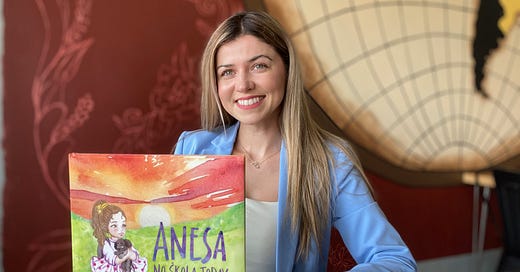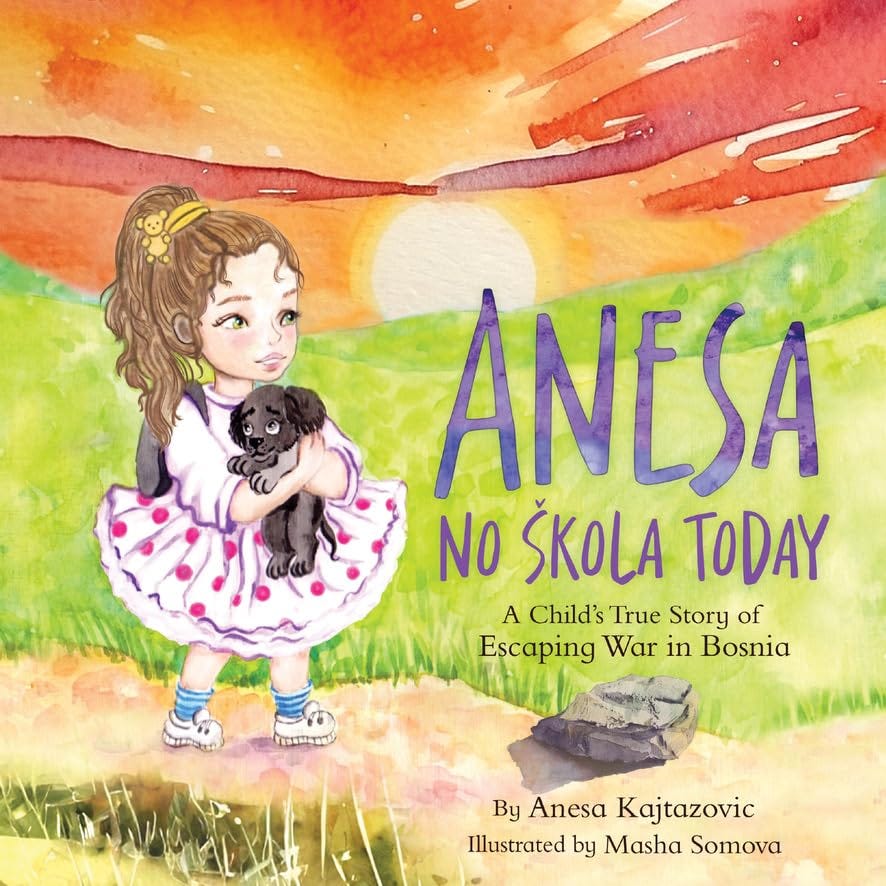
WATERLOO — There’s nothing quite so heartbreaking as war through the eyes of a child.
Anesa Kajtazovic was that child.
She was seven years old at the outbreak of civil war in her native Bosnia-Herzegovina. A birthday, a new puppy, school days and the security of being surrounded by family and friends were all shattered by gunshots, bombs and the terror of fleeing home.
Now, the trailblazing former state lawmaker has summoned the courage to put her war experiences as a little girl into a book, “Anesa, No Skola Today.” It’s available June 24 but can be pre-ordered now on Amazon. A book signing event is scheduled for 4 to 6 p.m. Friday June 20 — World Refugee Day — at the Grout Museum in Waterloo.
It’s the culmination of five years of work and angst as she tried to put her experiences into a book children would be drawn to and understand as well as adults. It was a painstaking process.
“It’s not just a book; it’s about my life. And I want to tell my story exactly how it happened,” Kajtazovic said. “I want this to be a legacy to my nephews and all the other children, to be authentic and real.
“It’s not just my story,” she added. “It’s also the story of thousands of others from Bosnia and Herzegovina, and refugees in general: all children who go through trauma, loss and these emotions.”
Every image in the book brings a memory or a moment to life. She points to one illustration and said, “This was that moment I thought I lost my mom” as they fled their home, “and it was one of the worst moments of my life. Everything here resembles real life.”
A group of real photos of her early life before the war, growing up with her family, is in the back of the book,
“The reason I did this is to humanize these experiences,” she said. “Refugee children are normal children, just like every kid here that loves their toys, loves birthday parties, loves going to school, having friends, their favorite cartoons. And then it’s disrupted. My goal was to show the human side of refugee children, of children that go through war.”
She and her family spent three years in and out of refugee camps in Croatia, amid the seesaw battle for territory between the warring factions. In 1997, they were granted refugee asylum status and able to come to the United States. They settled in Waterloo, part of a sizable and vibrant Bosnian community within the city.
She has blazed her own trail since then.
After graduating from Waterloo West High School, she obtained multiple business and public administration degrees at the University of Northern Iowa.
In 2010, at age 24, she became the youngest woman ever elected to the Iowa Legislature and the first Bosnian American to hold public office in the U.S., serving two terms in the Iowa House of Representatives.
She’s now a development professional in the health care field with a nonprofit disease research foundation, having held similar positions with a local hospital and family service agency. And she has continued to be a very visible and active voice for the local Bosnian community.
Through it all, memories of the war and life on the run as a young girl were still a part of her. Five years ago, a teacher suggested she start telling her story, to her class. Kajtazovic started writing. Initial drafts seemed “too heavy” for elementary school kids.
“It started from like an essay,” she said, and the challenge was using the proper voice, and condensing and phrasing all that material into a format kids could appreciate and understand.
And there were few books like it, except for "Anne Frank: the Diary of a Young Girl” which Kajtazovic read and loved at age 11, about a Dutch Jewish girl and her family hiding out from the Nazis in World War II.
“So I really had to dig deep into my memories. And it was painful at times to bring that part of my life into words,” she said, her voice quivering slightly.
After working on it intermittently between her job and community activities, she finally completed it.
It wasn’t easy emotionally. Talking about it still isn’t. But in her mind, it had to be done.
“I wanted to bring the truth to life,” Kajtazovic said, her voice still betraying emotion. “I’ve never talked about what happened. And I’ve been asked so many times, what happened during the war. And I’ve never had the words or felt comfortable.
“And I still think I’m not completely comfortable to always talk about it,” she said. “But I know we need to. Because if we can educate others on what war does to children, what conflict does to innocent children, if we can touch people’s hearts, then I owe it to them to be their voice. It’s the least I can do.”
With children in school, Kajtazovic said, “we talk about how character counts; we talk about values like responsibility or respect, fairness and being a good citizen. How can we leave (out) the conversation of the millions of people who struggle? Why should we not educate children about what other kids just like them go through? I feel like in our education system, sometimes maybe we don’t spend enough time talking about the impact some of these world events have on children.
“But children see that other kids who go through this are not any different from them,” Kajtazovic said. “I hope children are able to see themselves in the story and to say ‘wow, this person is just like me.’
“And to have empathy and compassion,” she said. “That’s the way we can plant seeds of peace.”
She also hopes the book will allow readers to understanding loss as well. “I want children to be able to get many other themes out of this book. It’s about displacement, it’s about loss it’s losing what you know is normal — and overcoming that. Resilience and courage should be part of our conversation with children of these events.”

The Readers’ Favorite book review website calls Kajtazovic’s book a “moving tale that illustrates the resilient spirit of humanity and the power of hope amid adversity.”
The images as well as the story are autobiographical. “Every single image was based on my life,” she said. She worked with illustrator Masha Somova to re-create illustrations accurately depicting the inside of Kajtazovic’s home, her dresses and scenes of her family and neighbors fleeing their homes. Even the inside cover pages are a a print illustration of her favorite toys as a child.
She still has some of those toys, outfits and even the purse she carried her important documents in.
”That was actually the fun part for me, organizing the design of it,” she said. She even has one of her little skirts she used to wear — that little Anesa is wearing in the book.
Ironically, she completed the book at about the same time another eastern European war heated up, the Russia-Ukraine war. It just underscores the book’s contemporary and ongoing relevance, she said — and gave her additional impetus to see the project through.
“War changes your life,” she said. “Whoever you are, war changes your life.”
At one point in the process, she said, she thought she would never publish it. But “ I met some people along the way and they inspired me and encouraged me to keep going.
“I never imagined I would share this part of my life,” Kajtazovic said. “I’m a pretty private person. And so this is out of my comfort zone.” But she feels strongly “about education and the opportunity to share our stories with people, share out values, to share our point of view and simply educate people on what it’s like.
“I’m not unique in this. It’s a story for millions and millions of people today,” Kajtazovic added. “There’s over 40 million refugees worldwide and almost half of them are children. If you want to talk to kids about being a good citizen, about the values of responsibility, fairness and respect, how can we not talk about the millions of children who have suffered and go through something so traumatic?
“I love children. Children are so smart. They’re empathetic, they want to understand the world around them and I think we as adults owe that to them,” Kajtazovic said.
“I don’t want anyone to feel sorry for me” she also said. “I understand this better. I want to be a voice for these children. I want them to understand that we can overcome huge obstacles in our lives. I want to be an example of resilience, not a victim.
“It’s important to have these conversations so we understand each other and plant the seeds of peace,” she said, especially now. “I hope I can spark a bit of conversation about compassion, peace and freedom.”
Pat Kinney is a freelance writer and former longtime news staffer with the Waterloo-Cedar Falls Courier and, prior to that, several years at the Ames Tribune. He is currently an oral historian with the Grout Museum District in Waterloo. His “View from the Cedar Valley” column is part of “Iowa Writers Collaborative,” a collection of news and opinion writers from around the state who previously and currently work with a host of Iowa newspapers, news organizations and other publications. They are listed here. Clink on their individual links to check them out, subscribe for free - and, if you believe in the value of quality journalism, please support this column and/or any of theirs with a paid subscription. Thank you.





Thanks for the great uplifting story Pat. I love all your human interest reporting. I never knew Black Hawk county had so many interesting people! I guess you just have to get to know people and they probably all have a story. And you seem to have the right touch to bring it out. Thanks again.
Where would Waterloo be without our immigrants? Bosnians? Latinos? Burmese? The list goes on. They dominate our high school honor rolls. They're a big part of the community.